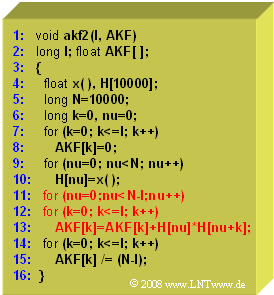Exercise 4.11Z: C Program "acf2"
From LNTwww
You can see on the right the C program "akf2" for calculating the discrete ACF values $\varphi_x(k)$ with index $k = 0$, ... , $l$.
In contrast to the program "akf1" from [Aufgaben:Exercise_4.11:_C_Program_"acf1"|Exercise 4.11]] here the algorithm described in the theory part is applied directly. It should be noted:
- Let the long value passed to the program be here $l=10$.
- The calculated ACF values $\varphi_x(0)$, ... , $\varphi_x(10)$ are returned to the main program with the float field $\rm ACF[ \ ]$ In lines 7 and 8, this field is prefilled with zeros.
- The random variable $x( \ )$ is defined as a float function in line 4, as is an auxiliary field ${\rm H}[10000 ]$, into which the $N = 10000$ samples $x_\nu$ are entered (lines 9 and 10).
- The names of the run variables in line 6 are adapted to the given algorithm.
- The actual ACF calculation is done from line 11. This program part is marked red in the program code.
Hints:
- This exercise belongs to the chapter Auto-Correlation Function.
- In particular, reference is made to the pages
Questions
Solution
(1) To calculate the ACF value $\varphi_x(0)$ is averaged over $\underline{N =10000}$ summands, for $\varphi_x(10)$ only over $\underline{N = 9990}$.
(2) Correct are the proposed solutions 1, 3 and 4:
- The computation time increases approximately linearly with $N$ and $l + 1$ as can be seen from the ACF calculation highlighted in red.
- In contrast, the computation time for the other parts of the program can be neglected.
- Naturally, the calculation also becomes more accurate with increasing $N$ .
- This goes here – in contrast to the program "akf1" of exercise 4.11 – however at the expense of the necessary memory requirement.
- Since each float variable takes up exactly four bytes, the auxiliary field ${\rm H}[10000 ]$ alone requires a memory of 40 kByte.
(3) Correct are suggested solutions 1 and 3:
- The stronger the statistical bindings within the random process, the less accurate is the ACF calculation for a given $N$ .
- This fact can be illustrated for example by the power calculation $($ACF value at $k=0)$ :
- If all $N$ samples are statistically independent, then all contributions provide the maximum information about the ACF–value $\varphi_x(k=0)$.
- However, if there are statistical bindings between $x_\nu$ and $x_{\nu+1}$, but not between $x_\nu$ and $x_{\nu+2}$, only half of all samples provide the full information about $\varphi_x(k=0)$ and the others provide only limited information.
- This loss of information based on correlations can only be compensated in this example by doubling $N$ .
- The last statement is also true, as explained in detail on the page "Accuracy of the numerical ACF calculation" in the theory section.
